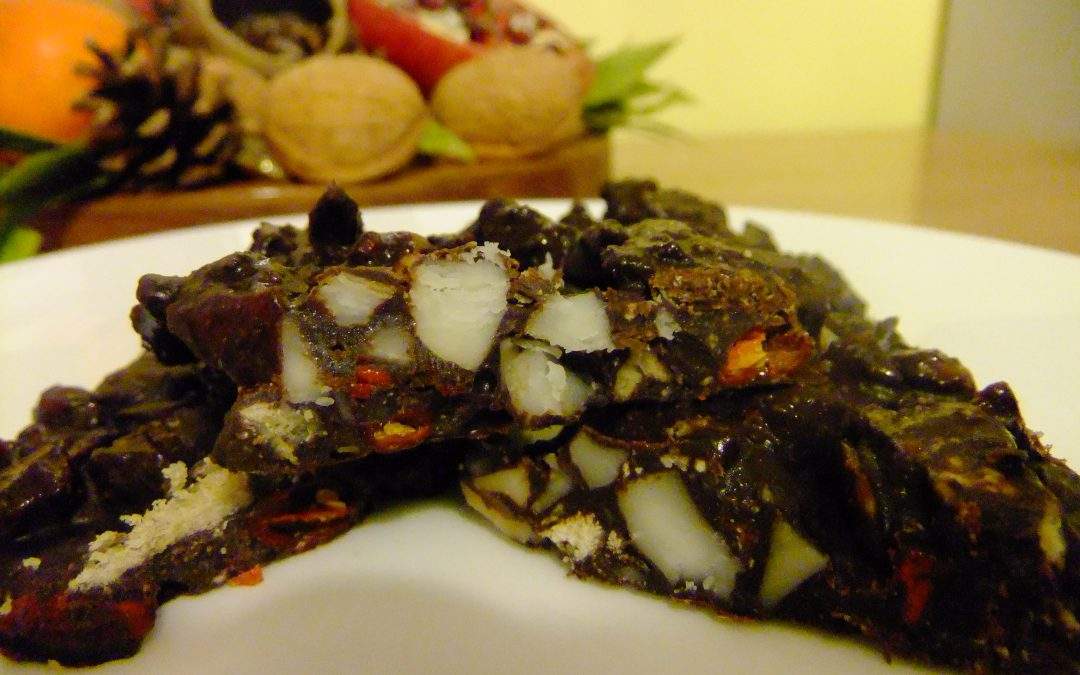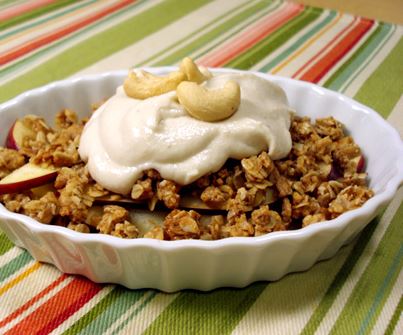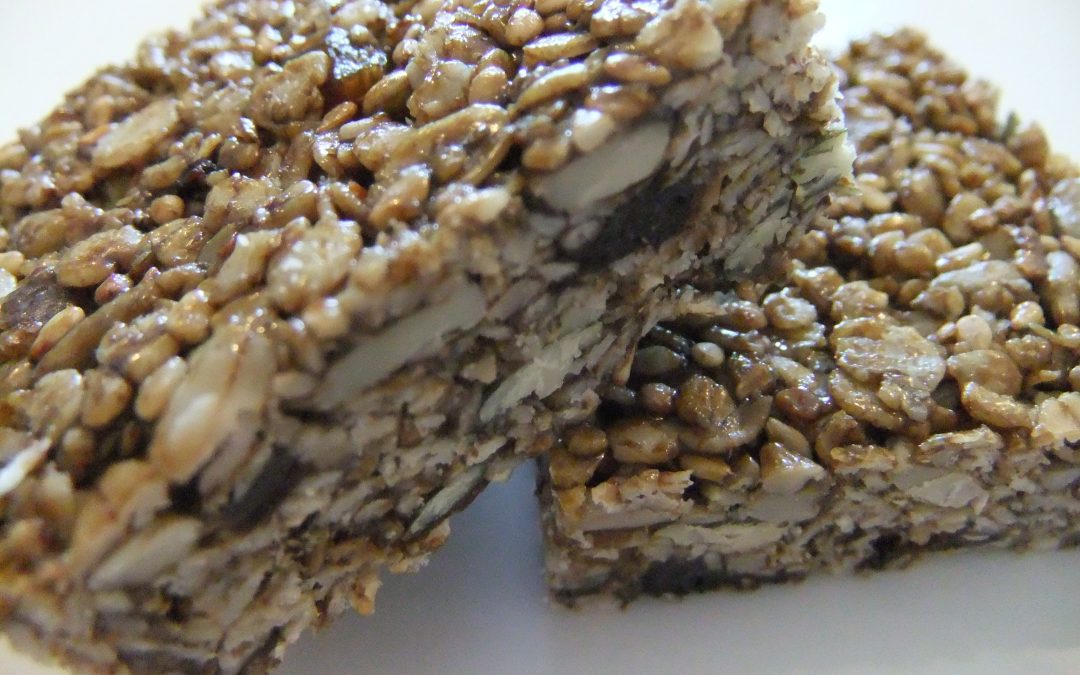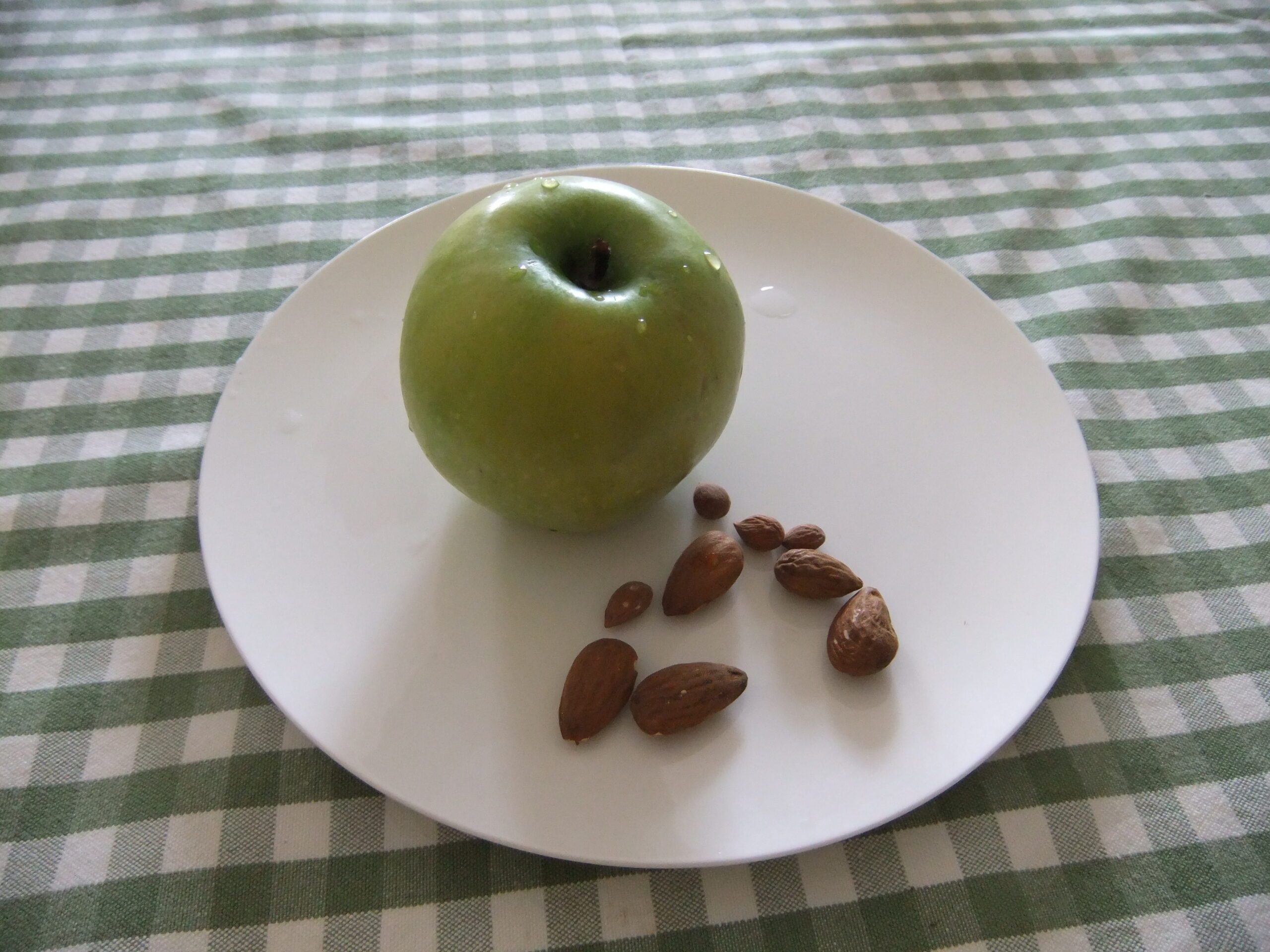
Dec 19, 2013 | Anna's Best Recipes, Cakes, biscuits & bars, Sides, starters, soups & snacks
I love this and so does everyone that tries it. It’s a really useful recipe: make a batch, cut or roughly break it up and keep it in the freezer. It can be served from frozen, which makes it wonderfully chewy and a little like a chocolate ice cream bar, and is a brilliant standby for when you have unexpected guests. It may taste decadent, but the ingredients are all very nutritious, the dark chocolate included. This recipe comes from Patrick Holford’s The 10 Secrets of 100% Health Cookbook.
Serves 10
200g dark chocolate, minimum 70% and ideally 85% cocoa solids, broken in to chunks
125g rough unsweetened gluten-free oatcakes (or normal unsweetened Nairn’s rough oatcakes if you are not gluten-sensitive)
50g goji berries
50g Brazil nuts, roughly chopped
50g pumpkin seeds
4 tsp ground mixed seeds (grind your own blend of flax, sesame, sunflower and pumpkin or use Linwoods milled mixed seeds)
2 heaped tsp ground cinnamon
50g hazelnut butter or unsalted no-added-sugar peanut butter – or make your own by grinding the raw nuts finely and mixing in a little extra virgin nut seed or avocado oil (or at a pinch, light olive oil) to make into a spreadable paste.
1. Melt the chocolate, stirring occasionally, in a heatproof bowl over a pan of gently simmering water, making sure the base of the bowl doesn’t touch the water.
2. Put the oatcakes into a mixing bowl and crumble into small pieces. Stir in the goji berries, nuts, seeds and spices.
3. Stir the nut butter into the melted chocolate and mix until fairly smooth. Stir the chocolate mixture into the remaining ingredients, making sure the ingredients are evenly coated.
4. Spread the mixture over a baking sheet and put in the fridge or freezer to chill and harden. Break into shards or cut into rough pieces when set, ready to serve.
Why this is good for you:
These crunchies are packed with raw nuts and seeds, a precious source of raw omega 6 oils. These oils are important for healthy skin, digestion, energy, mood and immunity. Most people have lots of cooked or refined omega 6 oils in their diets and these interfere with your body’s ability to use the good (raw) ones. Raw nuts and seeds and good quality (over 70%) dark chocolate are a good source of magnesium. Magnesium helps you feel chilled out and happy. It also helps your liver function more effectively. Good news after the Christmas excess…

Dec 19, 2013 | Anna's Best Recipes, Desserts & drinks, Dressings, rubs, spreads, sauces & more
I love this with Christmas pud or mince pies. This is a brilliant substitute for dairy cream and is naturally sweet. You want a mini food processor or a spice/coffee grinder to make this easily. I think these 2 gadgets are the best pieces of kit you can get for your kitchen if you want to eat lots of easy-to-prepare interesting and healthy food. Alternatively a mortar and pestle and a lot of effort would work. This “cream” keeps for at least 3 days in the fridge, covered. If it dries out a bit, just add a little water and mix well to smooth it out.
3 servings
½ cup unsalted unroasted cashew nuts
1 cup filtered water
A few drops of vanilla extract
Grinder or pestle-and-mortar method (for an even smoother consistency):
- Do not soak the cashews but grind finely, then beat in the water and vanilla essence with a whisk.
- If you want it thinner add more water, thicker add more ground nuts.
Mini food processor method:
- Soak cashew nuts overnight in the cup of filtered water
- Blitz all ingredients in a miniature food processor until it reaches a creamy consistency. Add more water to thin if you like.
Tip: You can make a similar “cream” using soaked and peeled almonds.
Why this is good for you:
Cashew nuts contain some protein and beneficial fats which help balance blood sugar, reducing the tendency to binge eat.. This is particularly great if you are serving with mince pies, plum pud or other high carb foods. Cashews are also rich in magnesium, which helps keep mood chilled, spirits high, blood pressure normal and much much more. People need lots of magnesium-rich foods at Christmas, when alcohol, white flour and sugar deplete this nutrient.

Nov 29, 2013 | Anna's Best Recipes, Cakes, biscuits & bars
This almond paste has a lovely “crunch” to it and tastes no different from the “normal” version. If you want a really smooth, non-crunchy paste, blitz the xylitol for a minute or two in a food processor or coffee grinder before using.
Makes enough to cover a 7″ square cake (or a 6″ cake with leftovers to make marzipan sweets from)
Don’t forget to check my “larder & shopping” section for unusual ingredients
450g ground almonds
450g xylitol or erythritol
2 eggs, organic if possible, otherwise free-range
2 tbsp Irish whiskey or brandy
1 drop pure almond essence (optional)
Gluten-free icing sugar* or finely ground xylitol (do this in a spice grinder) for kneading and rolling.
*most icing sugar is GF but do check the packet
- Mix the ground almonds with the xylitol.
- Beat the eggs, add in the whiskey and 1 drop of the almond essence, then add to the other ingredients and mix to a stiff paste (you may not need all of the egg).
- Sprinkle the work surface with gluten-free icing sugar or xylitol you have ground finely in a mini food processor or spice grinder, turn out the almond paste and work lightly until smooth and all the cracks have disappeared. You can store this in the fridge in an airtight container for up to a week until ready to use. The whiskey preserves the raw eggs in the paste.
Why this is better for you:
Swapping out the sugar for xylitol means this marzipan doesn’t put a massive strain on your immune system and cause inflammation in your body. While xylitol isn’t a vitality-boosting product it appears not to deplete nutrients. It prevents bacteria sticking to your teeth and has NO IMPACT ON BLOOD SUGAR. Erythritol is similar (without the bacteria blocking tooth effects). Unlike sugar, xylitol and erythritol are OK for diabetic people to use. Remember that sweet things like cakes and marzipan do displace really vitality boosting foods like fresh fruit and vegetables from your everyday eating. Like in the past, these treats are meant to be occasional treats and not staples in everyday life.

Oct 9, 2013 | Anna's Best Recipes, Breakfasts & smoothies
I knew I would be in a hurry the other morning with an early clinic so I threw together the ingredients for this deliciously thick smoothie the night before and blitzed them in the morning. If you like your smoothie thinner, add more liquid. If you prefer it thicker add less liquid and eat from the glass with a spoon like I do – yum!
For 1 hungry adult:
Remember to consult my “larder & shopping” section for unusual ingredients
2 rounded dsp high quality unsweetened protein powder of your choice – e.g. sprouted rice protein, hemp protein, Sun Warrior protein powder (or for a dairy option try Solgar Whey-to-Go Vanilla)
200ml unsweetened additive-free milk of your choice: almond, hemp, coconut milk, milk or (if you can eat gluten) oatmilk
1 ripe organic pear, washed
1 heaped tsp cocoa powder, organic if possible
1 heaped tbs flax or chia seeds, ideally soaked in water overnight
Optional: A pinch of pure stevia powder or a few drops of stevia drops to sweeten
Optional healthy delicious extras:
1/3-1/2 ripe avocado (extra filling and creamy)
1 heaped tsp soya lecithin granules
1 level tsp spirulina or chlorella powder
1. Cut the flesh off the pear (no need to peel) and throw in the liquidiser.
2. Add all the other ingredients. Blitz for a minute until smoothish. Enjoy.
Variation:
Pear and ginger smoothie: drop the chocolate and substitute 1 dsp grated fresh ginger root (peeled before grating).
Why this smoothie is better for you:
It’s almost always best to chew your food rather than grinding it up and drinking it. This is because food you have to chew stays in your stomach longer and makes you feel fuller longer too. Chewing your food mixes it with your saliva, starting the digestive process (with the enzyme salivary amylase) in the mouth so “chewing” this smoothie rather than gulping it down helps digestion enormously. Soaking nuts and seeds overnight starts the process of sprouting them, making their nutrients more digestible. Chia and flax, when ground, are a rich source of omega 3 fatty acids and minerals. Protein is an essential component of a good breakfast, helping regulate blood sugar to keep energy levels and mood even through the morning. Avocados are rich in monounsaturated fatty acids and vitamin E, great for moisturising skin and body fromwithin. Yoghurt and keffir provide friendly bacteria important for a healthy digestion, clear skin and stable mood. Fermenting makes the soya or dairy milk easily digested. Lecithin granules help emulsify (digest) fats and are a great source of phospatidyl choline. Phos choline is only found in egg yolks, lecithin and organ meats. Chlorella and spirulina are seaweeds so are rich in iodine. Iodine is needed for the body to effectively eliminate oestrogen (oestradiol), which in excess causes breast and other hormone-driven cancers. Fluoride, chlorine and wheat flour products suppress iodine utilisation in the body.

Sep 4, 2013 | Anna's Best Recipes, Cakes, biscuits & bars, Sides, starters, soups & snacks
I adapted this recipe by Xanthe Clay and the result was lovely – and easy to make. They are cooked in a frying pan rather than an oven, stick together really well and have a slight crunch. Unlike “normal” sugar, molasses is unrefined so still contains many nutrients. It has a sort of toffee flavour and can be a great choice for kids as it’s high in iron. Using the sunflower and pumpkin seeds raw at the end rather than toasting them on the pan will increase the nutritional value of the bars further but there will be a bit less crunch. Use organic ingredients where possible. Delicious as a snack or lunchbox filler.
Makes 24 small squares
25g gluten-free porridge oats* (or use normal porridge oats if you can eat gluten)
85g virgin coconut oil
55g sesame seeds
55g sunflower seeds
55g pumpkin seeds
85g dried chopped unsulphured* apricots, blueberries, raisins or sultanas
85g raw cane molasses
* Check out my “larder & shopping” section for where to buy all unusual ingredients
1. Line a baking tin around 27x18cm with silicone/baking paper cut to size
2. Heat a large frying pan and add the oats, sesame seeds, sunflower seeds and pumpkin seeds. Cook for about 10 minutes, stirring often at the beginning but more or less continuously toward the end to stop the mix burning. Its ready when you can hear the sesame seeds starting to pop and see the oats beginning to turn golden.
3. Tip into a ceramic or metal bowl or saucepan to cool and mix in the dried fruit.
4. Put the coconut oil with the molasses or honey in a saucepan. Heat the pan gently until the butter/coconut oil melts – do not allow to bubble.
5. Pour contents of the pan into the oat mixture. Stir until all the dry ingredients are well coated.
6. Tip the mix into the tin. Press down very firmly (it helps to put another sheet of non-stick parchment on tip). Allow to cool and then cut into 24 small squares or rectangles. Store in an airtight container for up to 10 days. After that, they tend to soften but can be firmed up by putting them on a baking sheet in the oven set to 160C and cooking for 15 minutes.
Why this is better for you:
If you are starting to convert your children (or yourself) from a high sugar diet then over time you can reduce the quantity of molasses or other sweetening you use in home baking. Cravings for very sweet foods are caused by mineral and vitamin deficiencies. As these are addressed, people start to be able to taste and enjoy foods which are less sweet. Oats are a much better choice than wheat if you want to avoid upsetting blood sugar balance as oat fibre slows digestion down, keeping you fuller for longer. Nuts/seeds also help delay the release of sugars (from grains, fruit and molasses) into the bloodstream. This helps balance blood sugar levels to help energy levels, brain function and immunity. This recipe is free of harmful refined vegetable oils. Virgin coconut oil is a useful source of medium chain triglycerides , that are used by the body directly to make energy instead of being stored as fat. The oils in the sesame seeds, although damaged by heating, cannot be absorbed by the body as whole sesame seeds are not digested (they are too small so pass through and out the other end intact!). As I mentioned before, you could avoid adding the pumpkin seeds and sunflower seeds until the end to boost the nutritional value of these bars further. Raw nuts and seeds contain beneficial omega 6 oils.

Aug 5, 2013 | Anna's Best Recipes, Desserts & drinks
We ate this for dessert last night, and I indulged again after a full breakfast this morning so am sitting here feeling a bit stuffed! This delicious mostly cake is very decadent and has a lot of good-for-you stuff. Technically its not all raw as cashew nuts are steamed after harvesting to make them edible. You can make this up to 5 days ahead if you like. The recipe is adapted from one by Laura Wright but I have reduced the syrups and given you alternatives for those hard-to-find ingredients. I also use cooked beetroot instead of raw, which simply doesnt break up well unless you have a super high speed food processor. Sometimes I make individual servings in mousse rings and store in a box in the freezer. I find that this cake quantity makes at least 10 so sometimes I make half the quantity for a smaller gathering.
It’s really important to use the mousse ingredients at room temperature not straight from the fridge – otherwise it solidifies instantly into an un-pourable mound with a grainy texture. I found out this by experience!!
For 1 x 22cm cake (to serve 10-12):
Remember to check out “larder & shopping” section in this blog for suppliers
Base:
310g raw almonds
30g raw cacao powder
¼ level tsp Himalayan or Atlantic Sea Salt
40g dried sour cherries (or use dried cranberries if you can’t get cherries)
8 medjool dates, pitted
1 tsp vanilla extract
1 rounded tbsp extra virgin coconut oil
Mousse:
325g raw cashews, soaked overnight in filtered water, at room temperature
330ml almond milk, at room temperature
155ml/140g extra virgin coconut oil, gently warmed to a liquid
60ml/4 level tbs/85g raw honey, raw agave nectar or maple syrup, at room temperature (tip: use a hot spoon to measure honey, if using)
Juice of 1 lemon, at room temperature
2 tsp vanilla extract
¼ level tsp Himalayan or Atlantic Sea Salt
115g frozen, pitted cherries (or raspberries if you prefer), thawed, at room temperature – or use pitted fresh cherries if in season
1 small cooked beetroot, chopped, at room temperature (shop bought will do)
1 x 22cm spring-form cake tin
A little extra coconut oil for greasing the tin
A food processor
Cling film (if making ahead and storing in the freezer)
1. To make the base, place the almonds in a food processor and pulse until chopped and resembling breadcrumbs. Add the cacao powder, salt, dried sour cherries, dates, vanilla and rounded tbsp coconut oil and blitz until the dried fruit is evenly distributed throughout the mix. When the mixture holds together when pinched, it’s ready to use. Grease the sides of your tin with a little extra coconut oil or rapeseed oil. Evenly press the base mix into the bottom of the prepared tin and set aside.
2. To make the mousse, remember that all the ingredients need to be at least at room temperature or else the mix thickens too quickly and becomes grainy and unpourable. Drain the cashews and combine them in the food processor with the almond milk, coconut oil, honey/maple syrup or agave, lemon juice and salt. Blend until smooth.
3. Pour all but 500ml (about half) of the mixture into the prepared tin. Add the pitted cherries and chopped beetroot to the remaining 500ml of the mixture. Blend until smooth and pour all but 250ml of this mixture quickly into the centre of the cake. Lightly drizzle the remaining mousse mixture around the top of the cake creating a decorative marbled effect.
4. To set the mousse cake: cover the tin with a plate and place in the coldest (bottom) shelf of the fridge for 6 hours or overnight. Alternatively, stretch cling film over the top of the tin and slide gently into the freezer for 6 hours or overnight. The cake will keep quite happily for a couple of weeks in the freezer. Remove from the freezer to thaw at room temperature for 1-2 hours before serving. When its soft right the way through (test with a needle), place in the fridge until you want to serve.
Dietary note:
Virgin coconut oil is a great source of medium chain triglycerides, a special type of fat that goes straight into energy production in your body instead of being used to make fat. For this reason, it is a healthier fat than butter. Coconut oil also contains capryllic acid, which has anti-fungal properties – good news for anyone with bowel issues or cystitis linked to candida. Cherries, red berries and beetroots are high in proanthocyanadins which strengthen connective tissue and the lining of your digestive system, reducing the tendency to diverticulitis, hernias and saggy skin. Raw almonds (and cold-pressed or “extra virgin” oils) contain vitamin E. This vitamin naturally lubricates and moisturises your skin, reduces the production of wrinkles, and also helps dampen down allergic reactions. Healthy skin does not need body moisturisers. “Raw” cashew nuts are, bizarrely, not raw at all – the nuts have to be steamed in order to be extracted from their hard shell. Cashews are a sweetish and healthier substitute for cream cheese, sugar and other not-so-great ingredients that tend to be used in desserts. Desserts like this one should be used as occasional treats and not eaten at every meal. They are still rich in natural sugars and if you eat them all the time, provide more calories than you need. A normal daily intake of raw nuts and seeds would not exceed a tablespoon or two.

Jul 8, 2013 | Anna's Best Recipes, Sides, starters, soups & snacks
Here’s a simple snack I used to eat 11 am to keep my concentration levels high and my energy up until lunch. When my health improved I was able to drop the snacks. Many of my clients have issues with energy fluctuations and snacks like this help while they sort out the underlying causes. This sort of snack gives slow-burn energy – unlike coffee or sugary/starchy foods.
Why this is good for you:
Almonds are high in calcium and magnesium needed for healthy bones, resilience to stress, and much more. Apples (especially organic with the skin left on) give you quercitin, which is anti-allergy, anti-inflammatory, and anti-aging. Apples are high in soluble fibre needed to feed healthy bacteria in the gut. An apple a day really does help keep the doctor away.







